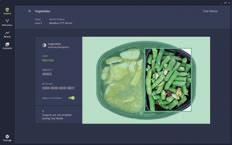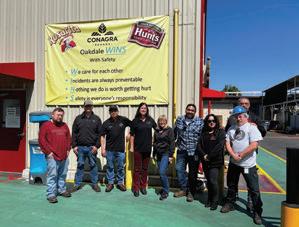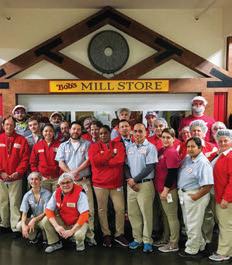
21 minute read
Packaging Technology
lenges in their business environment, but they’re still really chasing product attributes that help their brand more so than their bottom line.”
Conversely, improving product margins, frequently seen as a key innovation driver, fell relatively low among the priorities, along with managing inflation. “We did this survey in November and December of last year, though, so it’s possible that inflation pressures may have pushed up a little bit more since then,” Moses clarifies.
Sustainability
Circling back to the No. 1 product innovation driver, Moses notes that it was a big surprise just how aggressively manufacturers are pursuing sustainability. “Over 90% have net zero/carbon neutrality plans. About 85% of those want to reach that in 10 years, and over half want to reach it in five,” he says. “This was really notable to us that the sustainability targets were so aggressive.”
The sustainability targets are reflected even in the formulation of the pet food. When asked if they were planning to change their protein source, there seemed to be a fair bit of flux in the formulas, Moses says. “The ingredient that looks to be most targeted by producers to replace is animal muscle; 71% of the people that are using animal muscle plan to change that,” he points out. “We think that’s partly a reflection of the cost environment that we’re in, but we also think it’s a reflection of the sustainability targets.”
Animal muscle is not only the most carbonintensive ingredient in most pet food formulations, but there’s also competition for it in the human food space. “So we see that being swapped out for, potentially, animal visceral, which might be a play on upcycling and a little less carbon-intensive, even moving down towards plant-based protein.”
Convenience and selection
The pet food industry also has no plans to sacrifice convenience or selection despite the challenging business environment. “We asked, ‘Do you plan to rationalize any SKUs?’ just thinking that’s a way you can boost your capacity—fewer changeovers and cleaning, and better margins, too. That was something we saw during the pandemic; the variety that was being o ered was reduced, at least in the human food space,” Moses comments. “Again, we had a vast majority come back and say no, they don’t plan to do that.” That’s driven in part by the humanization trend, CRB hypothesizes, in which people want to o er their pets a variety of flavors.
Of those surveyed, 86% plan to make changes to their packaging, with moves toward resealable retort pouches and stand-up zipper pouches leading the way. That might be driven in part by food safety, Moses says, but much of it is likely driven by convenience. “We saw a push away from cans and more towards multi-use products that are convenient for the consumer to use,” he says. “The top five options are really about convenience and premiumization rather than margin and throughput.”
Food safety
“One of my favorite sections from the report is food safety,” Moses says. “It’s a very positive look on the industry.”
In fact, food safety has come a long way over the past 15 years in response to an evolving regulatory climate—namely, the Food Safety Modernization Act (FSMA). What the survey found was that food safety was not only a top driver of packaging changes, the ability to meet a food safety plan was the top driver of capital projects as well. Manufacturers are taking several actions to ensure they meet their food safety plans.
Almost half of all respondents indicated that their facilities rely on operational procedures (e.g., protocols to prevent the cross-contamination of raw and cooked food) and facility segregation to ensure safety and quality. Personnel hygiene routines related to Good Manufacturing Practices (GMP) rank high as well. Half of the largest companies have dedicated personnel for di erent production areas, and about one-third of smaller and midsize companies use this method.
“What the industry is doing tends to be pretty expensive things. They’re adopting a lot of bestin-class practices and spending the money to do it,” Moses says. “Again, that shows how serious the industry is about food safety.”
Overall, the pet food industry is advancing quickly, Moses notes, pointing to the use of artificial intelligence to improve operational e ciency and also to how integrated facilities are becoming. By strategically investing in automated technologies, pet food manufacturers will be able to improve existing facilities and optimize future expansions, CRB’s report notes. This will help to address some of today’s most pressing business challenges, including labor availability and inflation.
CRB
www.crbgroup.com
Download the full free Horizons: Pet Food Report.
DAN SILEO | CO-FOUNDER + CHIEF COACH-MANUFACTURING, FSO INSTITUTE STEPHEN M. PERRY, PH.D. | CO-FOUNDER + COACH, FSO INSTITUTE RUSS BENNETT | PLANT MANAGER, FLAGSTONE FOODS
No Man Is an Island, Even in Manufacturing
When mission, vision, purpose and values, and lean processes work, incredible results can be achieved. The OpX Leadership Network’s employee engagement characteristics help break down silos and islands of communication in manufacturing operations.
WHEN JOHN DONNE WROTE “No Man Is an Island” in 1624, he probably wasn’t thinking about the need for teamwork, collaboration, and interdependence in modern manufacturing. He was clearly thinking about humans doing better together than in isolation. Yet, this especially holds true for manufacturers seeking to improve productivity by breaking down silos that result in isolation.
Time and again, we have seen functions in manufacturing that work in silos and, in really bad cases, islands. This can happen on the shop floor (e.g., maintenance vs. operations), at the corporate level (e.g., engineering vs. procurement), or between the two departments (e.g., OT and IT). The results are lost productivity and continued cultural dysfunction.
Among the most significant factors contributing to silos and islands are: 1. No common vision, mission, purpose, and values—even if they are stated by the company. If key performance indicators (KPIs) and rewards and recognition systems are in conflict within di erent functions, it adds to the silo boundaries. 2. No engagement of people at the right level to address and solve issues across the perceived boundaries. 3. No common standard work processes to bridge the divide. Some people can bridge the gap with personality, but they are few and far between. Plus, it takes incredible e ort.
Companies will often spend weeks, months, and lots of money creating mission, vision, purpose, and values programs. But once done, are they just statements posted on the wall or distributed in a memo, or are they truly deployed, discussed, and checked for understanding at all levels of the organization? Is alignment to a common purpose driven into all levels of the organization? If you’d like fewer boundaries to be a common North Star in your company, try asking a shopfloor worker who has been with the company for several years if he or she can cite at least half of your values and some parts of the company’s mission and vision, or at least the current strategic issue he or she is working on.
Once a company’s mission, vision, and purpose are set, lean manufacturing has processes to develop strategies, play catchball, and deploy execution from the shopfloor up to senior leadership. Two major tools to help do this and break down barriers are Hoshin Kanri for strategic planning and a floor management
CASE IN POINT
FSO Institute reached out to Russ Bennett, plant manager at Flagstone Foods, regarding a recent challenge he faced due to silo thinking and what he did to break down those silos for improved productivity. FSO INSTITUTE: Russ, you recently were involved in a particular situation where productivity was being impeded due to lack of communication, protection of territory, and fear of sharing information. Can you brie y share that story, highlighting the steps you took to overcome these engagement challenges?
RUSS BENNETT: I was the plant senior production manager at the time, and we were having
major quality and throughput issues to the level that they were jeopardizing our relationship with a major customer. The departments within the plant, and even some leadership outside the plant, were not working in concert to deliver the required results. They were more concerned about their individual functional results, which created friction and took away from the energy of the whole facility to move forward.
We hired some engagement coaches from FSO Institute who worked with and taught us not only the lean FMDS process, but how servant leadership within this process can drive characteristics like communication, accountability for self and others, common vision, and cultural fit. We are continuing to learn how to apply the programs as a tool rather than a task in our continuous improvement e orts across all areas. We lost some people along the way because they were not a right fit, but we came out stronger at the end, and our retention has been steadily improving when most organizations are struggling to maintain employees. The beauty of what we have done has not only greatly accelerated our cultural growth and results while the coaches were here, we have continued to improve after they left.
That major customer I talked about is now very happy to see the organizational growth and improvements. If you don’t treat the processes and servant leadership as just a program or a task, and rather as a tool to guide the way you operate, sustainment and continued growth will follow. We are a far cry from perfect, but as a team, we utilize the tools we have learned to help guide us to strive to be a little better each day, create wins for those we serve, and bring ever-increasing value to our team and our customers.
display system (FMDS) for improved productivity. Companies can spend lots of money hiring a sensei or building a lean culture that can drive improvement. So, why do we hear about just as many failures or false starts as we do successes, and why do so many companies see it only as a manufacturing or, worse yet, a “plant thing?”
When mission, vision, purpose and values, and lean processes work, we all hear about the incredible results that can be achieved. But why do so many companies struggle? The secret sauce is engagement!
PMMI’s OpX Leadership Network Workforce Engagement Model has 47 characteristics across three pillars to help drive success. Although it is written in terms of the workforce inside a plant, the model can be applied at any level of an organization. A specific example of a characteristic is Enablement: Skills: Self Awareness. We all have seen leaders who are not aware of how they create and strengthen silos and get others to entrench in a position.
Forty-seven characteristics are too many to bite o all at once, but there are a few that focus squarely on removing barriers. It is important that your team select and align with a few characteristics you want to focus on. These characteristics include: • Empowerment: Desire: Team Contribution—To quote Mr. Spock, “The needs of the many outweigh the needs of the few…or the one.” • Empowerment: Authority: To Hold Accountable (Self and Others)—I am going to do what I say I will do, and I am going to hold you accountable for doing what you say you will do, regardless of what function you are in. • Enablement: Skills: Collaborative Thinking—Individuals don’t consistently come up with solutions on their own; they reach “across the aisle” and collaborate on a solution. • Enablement: Resources: Information—For example, a salesperson hears a customer concern related to production and makes up an answer to appease the customer, but never asks the plant to fix it. If the same problem happens again, the customer and the salesperson are now more frustrated and begin to refer to the plant as “those people,” putting a new brick in the silo wall. • Connection: Fit: Culture—Does your culture drive compliance (have to) or commitment (want to) in working across boundaries? The first is the minimum and has to be managed daily. The second is self-managed and taps into an employee’s discretionary e ort. • Connect: Communication: Goals and Objectives—Goals and objectives are balanced between metrics, performance, and personal development, and encourages all to cross boundaries of function and level to achieve success.
ABOUT THE OPX INTEL SERIES OF ARTICLES
PMMI’s OpX Leadership Network has produced more than 20 manufacturing process-improvement documents for CPGs and OEMs. The FSO Institute has facilitated the adoption and implementation of these documents, especially for food and beverage manufacturers. This series of articles shows how CPGs are using OpX and FSO documents to improve their overall manufacturing health and collaboration with OEMs and other suppliers. Learn more at www.opxleadershipnetwork.org and www.fsoinstitute.com.
DAVID GREENFIELD | EDITOR-IN-CHIEF, Automation World
Applying Arti cial Intelligence to Food Tray Production
Food producer apetito uses Neurala’s artificial intelligence technology to automate and optimize visual inspection of meal tray components.
SINCE 1958, APETITO has been supplying frozen foods and ready-to-eat meals to schools, nurseries, businesses, hospitals, and retirement homes across Europe and Canada. Production of its meal trays involves placement of di erent food items into trays for shipping and delivery. Complaints from customers about missing food items from trays led the company to seek an automated approach to final product inspection.
In its initial attempt to correct this problem, apetito began weighing each tray as it came o the production line. However, this did not adequately address the problem because if one food item on the tray was a little heavier than usual, it could falsely account for what was missing. In addition, apetito wanted to address other assembly e ciencies, such as ensuring each lid on its dessert containers was properly crimped and secured.
Starting with Raspberry Pi
One of the first steps apetito took to automate visual inspections was to apply a Raspberry Pi-based system to monitor one production lane. Photos of good and unacceptable products informed models connected to an output signal in the control system that would push rejects o the line. Without needing a human to do this job, the company saved more than £15,000 (about $17,700) in labor costs per year.
However, the Raspberry Pi system required hundreds of pictures of apetito’s products to be uploaded to a USB drive and then transferred to a computer to train the system over the course of three to four hours. The resulting knowledge then had to be transferred back to the line.
Whenever apetito made changes to its meal production operations to maintain appropriate stock levels, new training processes were required.
Though Rasperry Pi was not scalable or flexible enough for apetito’s needs, it helped the company realize how artificial intelligence (AI) could help apetito save on costs and detect production problems.

PHOTO COURTESY OF NEURALA
AI-based inspection
Neurala, a supplier of AI-based visual inspection technology, began working with apetito to detect cases of the five most reported missing components from meal trays using Neurala’s Vision Inspection Automation (VIA) software. VIA consists of two software programs, Inspector and Brain Builder. With apetito’s earlier weight-based inspection system, the company could only flag an incomplete tray, without understanding what was missing. With VIA’s ability to inspect multiple regions of interest on the trays, apetito can now see specifically which components are missing and identify trends in missing components to avoid their occurrence in the future.
To date, Neurala and apetito have built 30 AI “brains” across apetito’s plant to detect various food components used in food trays. For example, one brain developed to identify missing Yorkshire pudding components achieved 100% accuracy at the end of testing, assuring apetito could detect their most frequent missing component without fail.
“Throughout this AI-building journey, we’ve spoken with other companies in similar situations and are yet to find anybody in the food industry that is leveraging AI like we are with Neurala,” says Kevin McDonagh, operations manager for apetito.
Neurala
www.neurala.com
s Neurala’s Vision Inspection Automation (VIA) software helped apetito build anomalydetecting brains in as little as 10 minutes, thereby discovering what is missing from unique meal trays and identifying trends in missing components.
JOYCE FASSL | SENIOR EXECUTIVE EDITOR
The Race to Save the Planet Save the Planet




While many consumers look to retailers and product packaging to help them understand sustainability, the winners of ProFood World’s annual Sustainability Excellence in Manufacturing Awards are focused on reducing greenhouse gas emissions, electricity, and water, as well as food waste and materials management.
SUSTAINABILITY IS THE NEW WATCHWORD
for a huge and growing band of consumers, according to a June 2022 report from PMMI titled “Achieving Packaging Sustainability.” The ongoing green movement presents an opportunity for businesses facing increasing competitive and economic pressures to gain value in competitive advantage as they respond to environmental concerns and the pressures of resource scarcity, population growth, and higher and more varied consumer expectations.



Perhaps unfairly, the packaging industry is seen as one of the worst environmental o enders, the PMMI report states. At a recent Top to Top event held in Florida, PMMI hosted roundtables with participants from across the packaging value chain. Participants indicated that it’s not just CPGs that should be implementing sustainability strategies. OEMs also have a crucial part to play in energy savings. In fact, a current hot topic in Europe is a carbon footprint rating for each new machine. Download the PMMI report at pfwgo.to/nRThI.
Overall, the message from participants at the Top to Top meeting is that it’s all about the collaboration between CPGs, material suppliers, and OEMs as they plan ahead for the next generation of packaging materials.
However, while consumers continue to seek sustainable products, they may not be willing to pay the price, according to a recent report from market research fi rm AMC Global and OpinionRoute, a company that provides insights into process management. These survey results say that many consumers want sustainably produced and sourced products, but price remains the top consideration when making purchasing decisions. According to AMC Global, consumers believe these products are more expensive than their mainstream counterparts, and recent infl ation and price increases are making a ordability a key concern. In addition, a high percentage of respondents say it is hard to tell which brands are sustainable and which are not.
While 43% of people believe it is worth it to pay more for sustainable products, 66% say they can’t a ord to do so due to recent price increases across the board. You can learn more about AMC’s “Importance of Sustainability” report at pfwgo.to/tpRoA.
While consumers often look to retailers and product packaging to guide them on sustainability, the winners of ProFood World’s annual Sustainability Excellence in Manufacturing Awards are focused on reducing greenhouse gas emissions, electricity, and water, as well as food waste and materials management. Following are the six 2021 Program and Project Category winners.

FIRST PLACE PROGRAM CATEGORY No-cost Project Yields $1 Million Payback for Conagra Brands
The Oakdale, Calif., Conagra Brands facility makes Hunt’s and Ro-Tel brands, and other food products. Over the past year, the facility’s cross-functional team made excellent progress in reducing food waste. The team implemented a comprehensive plan and problem-solving program throughout 2021 to eliminate ingredient loss points for both jalapeños and tomatoes.


PHOTO COURTESY OF CONAGRA BRANDS
The program addressed three causes of jalapeño waste (spoiled ingredients, batch planning, and fi ll controls) and two processes for tomato waste (peelers and fi llers). As a result, the plant utilized 650,000 lb of jalapeño and 13.8 million lb of tomato raw ingredients compared to 2020, which reduced the site’s solid waste footprint by about 10%.
“By manufacturing food ingredients more e ciently, we are using utilities more e ciently,” says Kate Pitschka, director of supply chain sustainability, pointing to Scope 1 and 2 greenhouse gas (GHG) emissions. “We are also moving a signifi cant portion of the site’s food waste up in the recovery hierarchy from animal feed and compost.”
The plant is located in a high water-risk region, and eliminating some of the organic load being sent to wastewater operations is reducing some stress on the region’s water cycle. By eliminating food waste, the facility is reducing the amount of Scope 3 GHG emissions (EPA WARM and Biogenic) that the food waste would create downstream.
Teams were established during March to May 2021, project scopes were defi ned within one to two months, and specifi c projects were implemented between July and October 2021, resulting in a 4% jalapeño yield improvement and a 1.8% tomato yield improvement.
“Savings were strictly through better use of available equipment resources and process improvements, with limited costs,” explains Pitschka.
The Oakdale cross-functional team delivered a $471,000 jalapeño yield loss reduction (spoiled ingredients, under net weight rejections, and overfi ll) and a $730,000 tomato yield loss reduction. These calculations do not include the energy cost savings associated with treating the food waste going to wastewater, nor the hauling costs of the solid waste.
The team discovered that of the 650,000 lb of jalapeño waste, 236,300 lb were from spoiled jalapeño ingredients, resulting in a 4% year-over-year yield improvement and an elimination of all spoiled ingredients in 2021.
Conagra Brands’ Oakdale, Calif., facility created a cross-functional team that made excellent progress in reducing food waste.
Download the 2022 PMMI white paper, “Achieving Packaging Sustainability.”
In 115 days, 6,900 tons of recovered tomato losses were achieved, representing a 1.8% yield loss improvement year over year. This tomato waste was going through a wastewater treatment system where solids are separated and sent to animal feed. “It is di cult to fully quantify the full comparison because of increasing production and some of this existing waste weight stayed in the water cycle, but the amount of solid waste produced by the site decreased signifi cantly during these specifi c months,” states Shelley Huskey, environmental manager. In the end, about 10% of the site’s total solid waste was eliminated from the prior year.
Programs like this have been implemented at other Conagra facilities, but the Oakdale team had to use problem-solving concepts and apply them to their lines, equipment, and circumstances. “More specifically, the foundational knowledge comes from the Conagra Performance System principles,” says Huskey.
Any manufacturing facility could implement the concepts of this type of problem solving, but like the Oakdale team, they will need to adjust it to meet their site-specifi c losses. “Often in a manufacturing setting, it is di cult to get past the reactionary mindset because of all the urgent issues that tend to arise, but it is crucial to shift to a proactive mindset in order to address problems like these,” Huskey adds.
TOTAL WASTE BY PERIOD - YOY Comparison
0 P01 P02 P03 P04 P05 P06 P07 P08 P09 P10 P11 P12 FY20 FY21 F22
COURTESY OF CONAGRA BRANDS
Food waste is greatly reduced at Conagra Brands’ Oakdale facility through better use of equipment and process improvements. Bob’s Red Mill employees intercepted product from the waste stream and were trained to identify donatable items.
SECOND PLACE PROGRAM CATEGORY Bob’s Red Mill Focuses on Wasted Food Rescue and Materials Management
Committed to creating a sustainable future while inspiring joy with wholesome foods, Bob’s Red Mill Natural Products fosters nourishing a healthy planet. One of the company’s main goals is reducing food loss from farm to fork through wasted food rescue. “By rescuing unavoidable scrap, we are avoiding climate emissions that would occur downstream,” says Julia Person, sustainability manager for Bob’s Red Mill. “We donate food to local non-profi ts, as well as send inedible product to animal feed. Another way we are furthering this work is by joining the Pacifi c Coast Food Waste Commitment to collectively work with other food businesses to cut food waste in half by 2030.”
The Milwaukie, Ore.-based company’s materials management focus extends beyond food waste to refuse, reduce, reuse, and recycle the maximum possible material fl ow at the plant, with a goal to reach zero waste. At Bob’s Red Mill, wasted food rescue and materials management programs have helped reduce operations costs for the employee-owned company and have a positive impact, both environmentally and socially, in the local community.
“In 2021, we kept over 385,000 lb of edible food from going to waste, upcycled 2,293 tons as animal feed instead of landfi ll or compost waste, and recycled more than 1,600 tons of materials such as cardboard, plastic, metal, and wood,” states Person. “Our food donations help provide healthy, wholesome food to those in need in our surrounding community.” Through donations to the Oregon Food Bank network, Bob’s Red Mill provided 161,521 meals to those experiencing hunger in 2021. It donated rescued food to four main organizations in the Portland, Ore., metro area—Oregon Food Bank, The Canby Center, Sunshine Division, and Gleaners of Clackamas County.

PHOTO COURTESY OF BOB’S RED MILL







